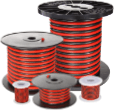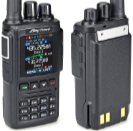Two-Way Radios
DMR Contact CSV Files
These downloadable Worldwide DMR contact ID CSV files can be easily imported into the radio programming software. Once imported, your radio will display the call sign, name, location and DMR ID during receive if an ID match is found. This list is updated daily.
- Anytone AT-D878UVII/AT-D578UV/AT-168UV (500K limit)
- Anytone AT-D878UV/AT-D868UV (200K limit)
Change your COM port number to a number less than 10
Some radio programming software does not work when Windows assigns a COM port number to your programming cable that is 10 or larger. Follow these steps to locate your COM port number, and change it, if necessary:
- For any version of windows, open the Run command by pressing and holding the Windows key on your keyboard, and then press "R"
- In the small Run dialog that opens, type "devmgmt.msc" and press Enter or click OK
- Click on the arrow to expand the group "Ports (COM & LPT)"
- Right click on the USB-to-Serial device and select "Properties"
- Click the "Port Settings" tab, then click the "Advanced..." button
- In the lower left corner, next to COM Port Number, click on the drop down box and select any COM number less than 10 (1 through 9) that does not say "(in use)"
- Click OK, then OK again
- You must reboot your computer for the new COM port number to take effect, and then try reading from your radio again
Missing or incorrect USB cable drivers
Missing or incorrect programming cable drivers will prevent you from being able to write or read to your radio. The Windows Device Manager can help indicate what the problem may be. To open Device Manager, follow these steps:
- For any version of windows, open the Run command by pressing and holding the Windows key on your keyboard, and then press "R"
- In the small Run dialog that opens, type "devmgmt.msc" and press Enter or click OK
- Click on the arrow to expand the group "Ports (COM & LPT)" or "Other Devices"
If you see a "USB Serial Controller" or similarly named device with a yellow triangle in these groups, then you are most likely missing the USB cable driver or have an incorrect version installed. First, try letting Windows update the driver software automatically:
- Right click on the device with the yellow triangle, and select "Update Driver Software..."
- Select "Search automatically for updated driver software"
- Let Windows search, and when complete, click OK
If you still see the yellow triangle, you will need to download the driver and run the installer manually.
Head on over to our Software Downloads section to obtain USB cable driver. Make sure to choose the correct download for your cable type and radio manufacturer.
TERA USB programming cable driver
The TERA USB Programming Cable (SKU: PRG-50), should require no driver download. Simply plug the cable (make sure it is detached from the radio) into your computer's USB port. Windows will automatically download the driver from Windows Update and install it.
If you receive an error message or the self-installation was interrupted, you can also download the cable driver from our Software Downloads section. Make sure to choose the correct download for your cable type and radio manufacturer.
Current A or Current B out of range
You can receive this message when attempting to write to your radio when you have not first read from the radio. Always read from the radio first, make your changes, and then write to the radio. You can also read from the radio first, and then save a file that can be opened later.
To resolve the error, go to the Optional Functions page and ensure the "A-Frequency Mode – Current" and "B-Frequency Mode – Current" contains a frequency within the transmit range of the radio(V: 144-147.995, U: 420-449.995).
Programming Software Downloads
Please see our special Software Downloads section for more information.
Third Party Radio Programming Software
There are many third party radio programing software programs available for download. Programs like "Commander" or "Chirp" should never be used to program radios. As these programs are not written by the manufacturer, they may cause permanent damage to your radio. Usually these programs overwrite important areas of the radio memory such as factory calibration data. At best, this may result in less than optimal performance of your radio. At worst, your radio could be permanently disabled.
Powerwerx is unable to repair radios that have been damaged by third party software. Due to the fact that these radios are unrepairable, the use of such software will result in your warranty being voided.
Black Wouxun programming cable
The older black Wouxun programming cables do not support modern versions of windows like Windows 10, 8.1, 8 or 7. We suggest upgrading to the newer red Wouxun programming cable (SKU: WXUSB) for the best compatibility and easiest installation experience.
Programming an amateur repeater with offset
When using an amateur repeater, your will need to enter the Receive (RX) frequency as well as the correct transmit (TX) frequency.
You can refer to your local repeater list or directory for a list of frequencies and their correct offset frequency and Encode tone. As you will see below, each state will vary their local frequency band plans.
The 2-Meter band uses a - or +.600 KHz shift when transmitting. The UHF (70 cm) band uses - or + 5.000 MHz shift. For example, in Southern California on the UHF band they use a (-) shift. While in Northern California they use a (+) shift on the UHF.
Let's say we want to enter a repeater frequency of 145.300 with a (-) minus offset.
We now have to calculate the repeaters offset (TX) frequency. 2M repeaters are always + or - 600 KHz. In most cases it's a minus (-) 600 KHz
So we would take the receive frequency of 145.300 and subtract .600 KHz for the repeater shift. So our TX frequency would be 144.700
In the RX Frequency column enter [1 4 5 . 3 0 0]
In our TX Frequency column enter [1 4 4 . 7 0 0]
We have now entered the correct RX & TX frequency for this repeater.
Programming the correct encode (transmit) tone to access the repeater
In addition to entering the correct RX & TX frequencies above, most repeaters also require the use of a CTCSS or Encode tone.
After referring to your local frequency list click on the "Encode" column and select the correct (TX) tone for this repeater.
In most cases the "Decode" column should stay blank with OFF selected.
Using the information above you can now enter a receive frequency, transmit frequency, encode tone and channel name for each memory channel.
Programming a receive only memory channel
Quite often, we may want to enter a frequency into a memory channel for listening only (no TX). Let's say you want to enter a NOAA weather channel for receive only into memory channel #50.
Open the programming software and on the left side of the screen, Click on "Channel Message"
Scroll down to memory #50.
Type in the receive frequency [1 6 2 . 5 5 0] and hit enter.
Next click your mouse on the TX frequency box. Now press the delete key.
You should now see a Receive frequency of 162.550 and the TX frequency should now be blank.
Scroll across to the right side of the screen and in the "CH Name" box type in a name of "WX1"
You have now entered a receive weather channel into memory #50 and have added a name of "WX1" to label this memory.
Repeat the steps above as needed for add additional memory channels for receiving with no TX in that memory slot.




